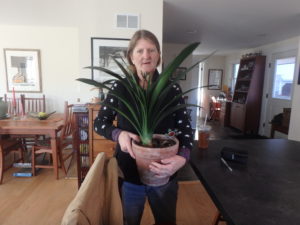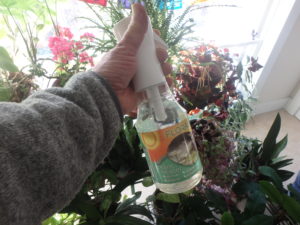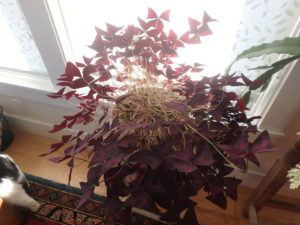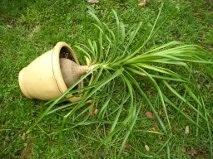Houseplants: How to Keep Them Happy and Healthy
I recently visited my friend Alicia Jenks of Green Dragon Farm in Weathersfield, Vermont, to take a look at her houseplants – some 50 or more of them. Alicia considers them her “indoor garden’, her plant friends that keep her gardening all winter. She doesn’t think houseplants are hard to maintain, but asserts, “You have to pay attention to them. They can’t take care of themselves.” Good point.
Alicia does not put her houseplants outside in the summer. Instead she keeps them on a covered screen porch. This allows her to regulate how much water they get, keeps them away from pests like earwigs, and keeps them from getting sun scald.
Before she brings them into the house in September, Alicia gives her houseplants a good gentle shower – outdoors, with a hose. Aphids and other pests can often be knocked off with a stream of water, avoiding the need to use a soap solution to kill them later. Of course you must get the underside of leaves, too, and rinse the surface of the potting soil, too.
Alicia keeps her best, most luscious houseplants in the living-dining area. Her Junior Varsity team she keeps upstairs in a spare room. The rest, the Club Squad, stay in the basement under lights. She gives each the same care, and any plant can get upgraded to the living room. All it needs to do is bloom.
Water, too much or too little, is what kills most houseplants. Alicia does not follow a set schedule such as watering every Sunday, though that works for many people. Instead she regularly checks her plants by placing a finger on the soil surface. If it is lightly moist, she does not water. If it is dry, or if the leaves are losing some of their turgidity and wilting, she waters.
Alicia gives a deep watering each time she waters, enough so that a little water will seep through the pot’s holes in the bottom and into the saucer it sits on. In the summer when it is hot, she might have to water some plants every 2 to 3 days. In winter once a week may be enough.
What about fertilizer? Alicia gives some liquid fish emulsion fertilizer once a month from April to September. Fish or seaweed fertilizers are good for houseplants because they have a wide variety of nutrients, including many micronutrients that are not found in chemical fertilizers. During the winter? Most plants are not doing much growth then and should not be fertilized, she told me.
Most houseplants do not need much direct sunshine. Before you buy a houseplant, read the tag to see what it needs. Bright indoor sunlight is fine for most plants. Cyclamen, begonias, Christmas cactus, poinsettias, oxalis and many others will do well in a brightly lit room, without direct sunshine.
I have read that the direct sunshine diminishes exponentially with the distance from the glass. That means that sunshine two feet from the glass is 4 times weaker than sunshine a foot from the window, and at 3 feet away, it is 9 times weaker. Keep that in mind when you place a plant. Rosemary, which appreciates strong sun, should be as near the window as possible – without touching it. No plant leaves should touch the glass in winter.
Books and websites are full of advice. Still, I find the very best information about houseplants is found in my 1969 edition of Thalassa Cruso’s book, Making Things Grow: A Practical Guide for the Indoor Gardener. Although this book was written nearly 50 years ago and is long out of print, I have never visited a used bookstore that didn’t have it. And it is available on-line.
What I like about Ms. Cruso’s book is the practical nature of it. It covers pretty much any houseplant you can buy. She has grown it, figured out what makes it happy, and will save you the trouble of experimenting – and killing- houseplants yourself. Plus, her writing is easy to follow – and sweet.
Success is often in the details. Take those bright red zonal geraniums we often grow in pots in summer to adorn a sunny location. Did you know that they do best when their potting mixture is well patted down in the pot, compressing it? I didn’t. Or that geraniums can be made to flower beautifully indoors in winter by pinching them back regularly in summer, frustrating their attempts to blossom until winter? Ms. Cruso taught me that.
Alicia Jenks does not re-pot her plants very often. She believes that many bloom better if the roots are a little crowded, but if the roots are pushing out the top or through the drainage hole, it might be necessary.
Thalassa Cruso warns against “potting on’ a root-bound plant into a much larger pot. She explains that using a pot more than an inch in diameter larger than the pot a plant is growing in can cause root rot. Why? The excess soil material will not easily dry out – because the roots will not reach it.
I never think of myself as a houseplant kind of guy, though when I counted up my houseplants for this article I saw I had 43 plants, including a Crown of Thorns that is over 100 years old, a banana tree, a fig, an 8-foot hibiscus and an even bigger frangipane tree that bloomed all last winter!
Henry is away, and will not be answering e-mail this week. His website is Gardening-Guy.com. He is the author of 4 gardening books.
Making Houseplants Happy In Winter
Making Houseplants Happy in Winter
I’m sure you’ve had the same problem I do now: aphids on your houseplants. We’ve had them outside all summer, and they never showed signs of any aphids. But bring them inside and we have those little bugs sucking their juices out (because there are no good bugs inside eating those pesky aphids). Aphids are less than a quarter of an inch long, often clear or light brown, and leave stickiness all over the leaves. What’s a person to do?
First, you should wash the plants before they move indoors. I put them on the lawn and spray them with a vigorous stream of water from the hose. Not enough to rip leaves, but a good strong spray. It is important to get both sides of the leaves washed, the stems, and the soil surface. That’s right, turn the plant on its side and spray the soil to wash off eggs or aphids lurking there.
If you have already brought in your plants, inspect them daily for signs of aphids. I know the plants that, year after year, are most susceptible to aphids. I keep them in isolation, even if I have washed them off. I love my potted Impatiens that I have on the north-facing deck all summer, and want to keep them over from one year to the next – but I know I will have aphids on them. And someone gave me a potted Meyer lemon tree – in part because it is a magnet for aphids.
Another technique to minimize aphids only works on things like rosemary, which is somewhat frost hardy: leave them outside to go through a few frosts before bringing them in. That will allow Mother Nature to kill off the aphids for you. But be careful – it’s easy to kill off plants if it gets too cold.
Then there is the “let-it-go-dormant” approach to tender plants. Many houseplants were originally from Africa or other tropical places. If they go dormant in their native country during the dry season, you can probably let them go dormant for you here. I have let my oxalis and ginger plants get completely dry for months at a time, and they come back to life when watered in the spring. They should not be kept in a warm room, however, so try to keep them at about 50 degrees, and preferably in a dark room – or in a brown paper bag.
Plants that have been outside all summer get cranky when brought inside, but you can help their attitude by providing the right amount of light and water. Too much water is a common cause of root rot and plant death or decline. Outdoors there are nice breezes to evaporate excess water in the soil, summer temperatures are warmer, and sunshine is stronger. So water only when the soil is dry to the touch an inch down. If you know your plants and pots, you can tell if water is needed just by hefting the pot.
If you have city water, it has chlorine in it, and many plants do not like chlorine. But that’s easy to fix: plan ahead. Fill a pitcher of water in the evening, and most of the chlorine will evaporate by the next night. Or you can use brook water, rain water – or heck, Perrier, if you want!
Light is another issue. The glass of your windows absorbs a lot of energy of the sun – it’s why you cannot get a tan indoors, even lying in the sun room all day with the Sunday New York Times. Sun-loving plants are the hardest to please. This year I have set up some LED lights over three of my large plants. These lights use much less energy than fluorescent lamps (28 watts to get the equivalent of 250 watts of standard incandescent light), and are sold specifically for growing plants. Mine are from Sunshine Systems (www.sunshine-systems.com or 866-576-586), their Glow Panel 45. Each panel has 112 little red or blue LED lights. I put mine on a timer so they will turn on and off automatically. They are not inexpensive, but should last for 50,000 hours. I shall see this year if that supplemental light will make a big difference to my plants.
South facing windows are best for sun-loving plants. Get your plants as close to the glass as you can, I put several pots in a big window in a rubber boot tray that I got from Gardeners Supply Company (www.gardeners.com or 888-833-1412). The tray keeps spills from getting onto the floor.
Humidity is a problem for some plants in winter, especially orchids. You can increase the moisture around your plant by putting the pot in a saucer filled with gravel. Keep water in the saucer and it will evaporate, while avoiding the problem of roots sitting in standing water, which is almost universally bad for plants.
Knowing your houseplants and what their needs are is half the battle of having nice ones. The best book I have encountered on caring for houseplants, and the specifics on individual plants is no longer in print, but is readily available in used bookstores. It’s called Making Things Grow: A Practical Guide for the Indoor Gardener by Thalassa Cruso.
If do get aphids, even after washing them outdoors, spray them with Safer Soap, a product that is safe and easy to use – or or take them with you the next time you shower!
Henry’s new book is Organic Gardening (not just) in the Northeast: A Hands-On, Month-by-Month Guide. His Web site is www.Gardening-guy.com.






